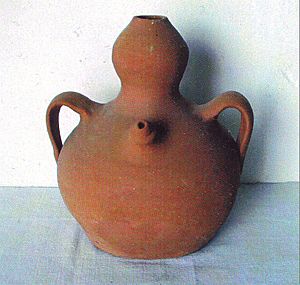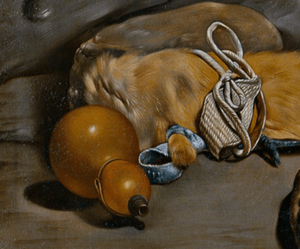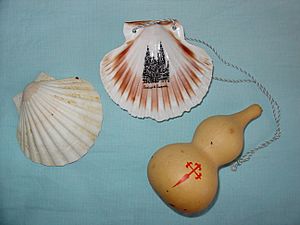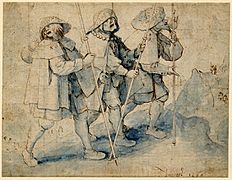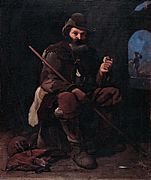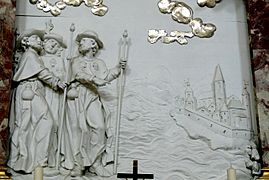Shepherd's gourd facts for kids
A shepherd's gourd is a special container used to carry water. It looks a lot like a gourd or pumpkin. People also call it a "shepherd's jug." It has a wide neck, which makes it easy to tie a rope around it. This way, you can carry it or attach it to something else.
Long ago, these containers were made from real, hollowed-out gourds. Later, potters started making them from clay. They copied the gourd's shape to create different kinds of jars and canteens. The shepherd's gourd is often seen with the pilgrim's scallop. Both are symbols of travelers, especially those on the Way of Saint James.
What's in a Name?
The shepherd's gourd has a few other names. Some people call it a "pumpkin jug" or a "pilgrim's barrel." A dictionary expert named Caro Bellido described it this way. He even mentioned that Menéndez Pidal, another famous scholar, said "gourd" was an old word for a "gourd-shaped container."
Experts like Jesús Lizcano, who studies old pottery, believe these gourds could hold about two liters of water or wine. This made them very useful for people traveling or working far from home.
A Look at History
The plant that gives us these gourds is called "Lagenaria siceraria." It's a tropical plant related to pumpkins and squash. Scientists think it's one of the oldest plants ever grown by humans!
In 1968, a botanist named Herbert George Baker found gourd pieces in Egyptian tombs from around 3500 to 3300 BC. He also found them in ancient Peruvian graves from about 3000 BC. Even older gourd remains, about 7000 years old, were found in cave cultures in Mexico.
Scientists have even done experiments to show how tough these gourds are. They found that gourd seeds could float in seawater for two years and still grow! This means gourds might have traveled across the Atlantic Ocean a long, long time ago. Other experts think they might have crossed the Pacific Ocean before the Americas were discovered.
People in many different cultures, both in Europe and the Americas, used gourds as jugs or canteens. These gourds came in many sizes, from small (about 10 cm) to large (about 60 cm). Their different shapes and light weight made them perfect for early travelers, like pilgrims.
Gourds in Art
Shepherd's gourds appear a lot in art. You can see them in pictures of shepherds, pilgrims, and farmers. Especially farmers taking a break from harvesting! They are also found in sculptures and carvings in European art, dating back to the 11th century.
- Pilgrims
See also
 In Spanish: Botijo de pastor para niños
In Spanish: Botijo de pastor para niños


